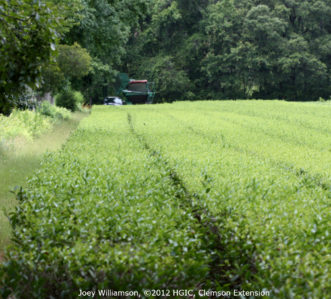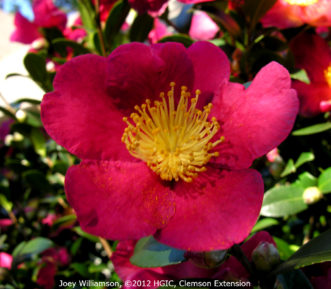Camellia japonica ‘Berenice Boddy’ blooming in February with semi-double flowers.
Karen Russ, ©2007 HGIC, Clemson Extension
Camellias are large, attractive, broad-leaved, evergreen shrubs that are highly prized for their flowers, which bloom from winter to spring. There are more than 2,300 named cultivars registered with the American Camellia Society. In South Carolina the primary camellias used include cultivars of Japanese camellia (Camellia japonica), Sasanqua camellia (C. sasanqua and two closely related species, C. hiemalis, and C. vernalis), tea camellia (C. sinensis), tea-oil camellia (C. oleifera), and many hybrids using two other species extensively (C. reticulata and C. salvenensis).
Mature Height/Spread
Common Japanese Camellia (Camellia japonica) is a broadleaved, evergreen shrub, which may grow to a height of 25 feet, but more often to 6 to 12 feet. It has a spread of 6 to 10 feet. The dark-green leathery leaves are 4 inches long. The flowers, which range in color from white to pink and red, are 3 to 5 inches in diameter. They flower on different varieties from September until April. The flowers may be single, semi-double, double, formal double or full peony form. Some Japanese camellias, around the emperor’s palace in Japan, are known to be more than 500 years old.
Camellia sasanqua, along with C. hiemalis and C. vernalis, are broad-leaved evergreen shrubs, varying in form from upright and densely bushy to low and spreading. Heights range from 1½ to 12 feet tall. The leaves are dark green, shiny and about 2 inches long. Their leaves are usually darker green and smaller than the leaves of C. japonica or C. reticulata. The flowers are mostly single or semi-double, 2 to 3 inches in diameter, and very fragrant.
Tea camellia (Camellia sinensis) grows to about 10 feet tall and has been in cultivation for three thousand years. New leaves are harvested to produce tea from plants that are kept pruned to waist high. Green, black, white and oolong teas all are produced from the tea camellia foliage. Culture of tea camellia is the same as for other camellia species, and it will grow throughout South Carolina (USDA cold hardiness zones 7-9).
Tea camellia flowers in the fall, and the straight species has white flowers. The variety ‘Rosea’ has pale pink flowers, and new foliage has a reddish tint.
Tea oil camellia (Camellia oleifera) is a large shrub to 20 feet tall with glossy, dark green leaves and fragrant, 2-inch-wide flowers in fall.
Pink-flowered tea camellia (Camellia sinensis ‘Rosea’) blooming in October.
Joey Williamson, ©2012 HGIC, Clemson Extension
Camellia reticulata has some of the biggest and most spectacular flowers, but is a rather gaunt and open shrub, about 10 feet tall and 8 feet wide.
This species is very susceptible to cold. Mild frost will kill the plant. Camellia reticulata hybridized with C. japonica or C. saluenensis results in excellent hybrids.
Growth Rate
Harvesting the new foliage in hedges of tea camellia (Camellia sinensis) in Charleston, SC at the Charleston Tea Plantation.
Joey Williamson, ©2012 HGIC, Clemson Extension
Japanese camellias grow very slowly and can grow to be quite old. Some hundred-year-old plants may reach 25 feet high or more and as wide, but most gardeners can consider camellias to be 10-foot-tall shrubs. Many are even lower growing. Camellia sasanqua cultivars are faster growing than C. japonica.
Landscape Use
Camellias are used as specimen large shrubs, shrub borders and screens. The main ornamental feature is their showy flowers.
Cultivation
Camellias need well-drained soil rich in organic material for establishment. Because camellias are slow-growers, they are slow to get established. Competition for water is the one critical thing in establishment. They thrive and bloom best when sheltered from full sun and drying winds. Older camellia plants can thrive in full sun when they are mature enough to have their roots shaded by a heavy canopy of leaves.
Camellia vernalis ‘Yuletide’ with single form, crimson red flowers in November.
Joey Williamson, ©2012 HGIC, Clemson Extension
Camellias can be planted any time of the year (preferably from October to November and from March to mid-April) provided they are properly planted and mulched and checked for water frequently. Camellias are shallow-rooted plants. They must be planted shallowly. It is recommended to dig a large, deep planting hole to cut the roots of neighboring trees, which will otherwise compete for water with the newly planted camellia. Also remove stones and break up heavy clay soils. Partially fill the hole with loose soil before planting the camellia shallowly.
Soil moisture should be conserved by using a 2- to 3-inch layer of mulch. Camellias prefer a slightly acid soil, and light applications of an azalea and camellia fertilizer during the spring may be used to maintain dark-green, attractive foliage. Follow the instructions on the fertilizer label. Do not use more than called for. Burned leaf edges and excessive leaf drop usually indicate over-fertilizing.
Some flower bud dropping may be a natural phenomenon. Many camellias set more buds than they can open. Bud drop can be caused by under-watering in the summer.
Camellias require very little pruning except for the removal of damaged branches and long shoots that detract from the attractive form of the shrub. Cutting back severely (no leaves left) can be done safely from Valentine’s Day to around May 1. Cutting out the dead and weak stems can be done anytime.
Problems
Three diseases and one insect pest are serious on camellias in South Carolina:
- Dieback and canker
- Root rot
- Camellia flower blight
- Tea scale
For more information on diseases and insect pests on camellias refer to HGIC 2053, Camellia Diseases & Insect Pests.
Cultivars
Camellia japonica ‘Pink Perfection’ blooming in March with formal double flowers.
Joey Williamson, ©2012 HGIC, Clemson Extension
Camellia japonica cultivars: Following is a list of C. japonica cultivars that are old standbys. The listing specifies bloom season, flower size, color and petal configuration. The earliest types start blooming in November in the Low country, while late varieties still have flowers in May. Very large flowers are over 5 inches in diameter, large are 4 inches, medium are 3 inches, small are 2 inches or less across.
- ‘Adolphe Audusson’ – Midseason; very large; semi-double, dark red.
- ‘Betty Sheffield Supreme’ – Midseason; large; white blotched with red and pink.
- ‘Berenice Boddy’ – Midseason; medium; semi-double, light pink.
- ‘Daikagura’ – Early-late season; large; rose- pink blotched with white.
- ‘Debutante’ – Early-midseason; medium-large, full peony form, light pink.
- ‘Desire’ – Midseason; medium large; formal double, pale pink edged in darker pink.
- ‘Kramer’s Supreme’ – Midseason; very large; full peony form, red.
- ‘Kumasaka’ – Midseason-late; medium-large; semi-double, pink; plant size 6 to 8 feet tall.
- ‘Lady Clare’ – Midseason; large; semi- double, dark pink; above-average cold hardiness.
- ‘Magnoliaeflora’ – Midseason; medium; semi-double, pale-pink.
- ‘Mathotiana’ – Midseason-late; very large; formal double, crimson.
- ‘Guilio Nuccio’ – Midseason; very large; semi-double, coral rose.
- ‘Nuccio’s Gem’ – Midseason; medium-large, formal double, white.
- ‘Pink Perfection’ – Early season; medium; formal double, pink.
- ‘R.L. Wheeler’ – Late; large; semi-double, rose pink.
- ‘Rev. John G. Drayton’ – Late season; semi-double; carmine-rose.
- ‘White by the Gate’ – Mid- to late-season; medium; white; plant size 6 to 10 feet tall.
Camellia sasanqua ‘Shishi-Gashira’ blooming in November.
Joey Williamson, ©2012 HGIC, Clemson Extension
Camellia sasanqua cultivars:
- ‘Egao’ – C. vernalis; medium; semi-double, rose pink
- ‘Hana Jiman’ – Medium; white edged in pink.
- ‘Jean May’ – Large; pink; excellent variety, but very susceptible to leaf gall disease.
- ‘Kanjiro’ – C. hiemalis; large; semi-double, rose pink; vigorous growing plant to 10 feet tall.
- ‘Pink Snow’ – Large; semi-double, light pink; outstanding.
- ‘Setsugekka’ – white; semi-double, large ruffled petals; vigorous plant growth to 10 feet tall.
- ‘Shishi-Gashira’ – Mid-season; medium; semi-double, dark pink; drought tolerant; plant size 4 to 5 feet tall.
- ‘Yuletide’ – C. vernalis; small; single, crimson-red; slow growing.
Camellia x williamsii ‘Debbie’ with rose pink blooms in March. This is a hybrid between C. japonica and C. saluenensid.
Joey Williamson, ©2012 HGIC, Clemson Extension
Recommended camellia hybrids:
- ‘Valley Knudsen’ is a hybrid between C. reticulata and C. saluenensis. Midseason-late; large; semi-double, deep orchid pink.
- ‘Dr. Clifford Parks’ is a hybrid between C. reticulata and C. japonica ‘Kramer’s Supreme’. Late season; very large; semi-double to peony, intense red with orange cast.
- ‘Mona Jury’ (C. x williamsii) is a hybrid between C. saluenensis and C. japonica ‘Daikagura.’ Large; peony form, apricot pink; slow growing shrub.
- ‘Debbie’ (C. x williamsii) is a hybrid between C. saluenensis and C. japonica ‘Debutante.’ Peony form, rose pink; vigorous shrub.
Many different camellia cultivars and their descriptions may be found at the American Camellia Society website: www.americancamellias.org.
Originally published 12/98
If this document didn’t answer your questions, please contact HGIC at hgic@clemson.edu or 1-888-656-9988.








